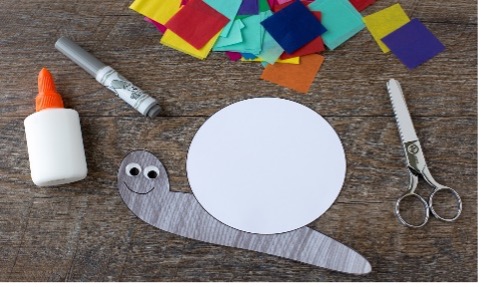Crafting isn’t just about making something pretty; it’s about engaging the senses, sparking creativity, and providing a therapeutic outlet for children of all abilities. If you’re looking for a delightful sensory craft that’s perfect for kids, especially those benefiting from autism behavior support or participating in ABA therapy, then look no further than making tissue paper snails.
What You Need:
- Tissue Paper (cut into 1 ½ inch squares)
- White Glue
- Pencil
- Markers
- Scissors
- Tape
- Wiggly Eyes
- 1 Pipe Cleaner
- Snail Printable
Directions:
- Coloring Fun: Start by inviting the kids to color the snail’s body using markers. While we chose a grey marker, any bright color will work wonderfully to bring your snail to life.
- Cut and Assemble: Using scissors, carefully cut out the snail’s body and shell from the printable. Tape or glue the snail’s shell to the top of the body, creating the snail’s distinctive shape.
- Eye-catching Detail: Glue two wiggly eyes to the snail’s face, then draw a cheerful smile using a black marker to add personality to your creation.
- Tissue Paper Magic: Press a piece of tissue paper around the eraser end of a pencil, creating a small, fluffy ball. Squeeze a drop of glue on top of the tissue paper ball, then press it onto the snail’s shell. Repeat this step until the entire shell is covered with colorful tissue paper circles.
- Group Crafting Option: If you’re making this craft with a large group of kids who are sharing supplies, consider pouring glue onto paper plates. This way, children can easily dip their tissue paper squares into the glue, making the process even more enjoyable and accessible for everyone involved.

Benefits for Autism and ABA Therapy:
- Sensory Exploration: Handling the tissue paper, squeezing glue, and creating textured artwork engages multiple senses, providing valuable sensory input for children with autism.
- Fine Motor Skills: Cutting, coloring, and gluing help develop fine motor skills and hand-eye coordination, essential for daily activities and academic success.
- Creativity and Expression: Crafting encourages self-expression and creativity, allowing children to express themselves in a non-verbal way, which can be particularly beneficial for those undergoing ABA therapy.
- Social Interaction: Crafting in a group setting fosters social interaction, communication, and cooperation, promoting positive social skills development and peer relationships.
By incorporating sensory-rich crafts like tissue paper snails into your activities, you’re not only providing a fun and creative outlet but also offering numerous developmental benefits for children, including those with autism or receiving ABA therapy. So gather your supplies, unleash your imagination, and let the crafting adventure begin!

If you’re interested in learning more about how ABA therapy can benefit your child, or if you have any questions, please don’t hesitate to contact us. We’re here to help you on this journey. Give us a call at (855) 444-5664 to get started!
Spring into sensory friendly fun at our blog like making Handprint Flowers, and Paper Plate Butterflies!


